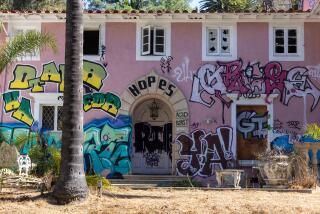Would the sheik’s mansion shock us today?
Bad taste is in the eye of the beholder. Tourists guided by maps to the stars’ homes gawk admiringly at L.A.’s uppity residential neighborhoods. Woody Allen, on the other hand, has long voiced the opinion that L.A. is the epicenter of tackiness, and he has filmed the streets of Beverly Hills in a way that mocks the area’s stylistic diversity. (You mean a Palladian villa doesn’t complement the Tudor mansionette next door?)
In 1979, Sheik Mohammed al-Fassi’s very conspicuous home on the northwest corner of Sunset Boulevard and Alpine Drive achieved an unprecedented consensus on the Beverly Hills definition of really, really, we-hate-it bad taste. First, the then-young sheik painted his 38-room white Italianate mansion the color of minty fresh toothpaste. Then, he surrounded it with urns filled with plastic flowers. The coup de grace, however, was painting the white plaster statues of nude men and women to highlight their genitalia.
The sheik died Dec. 24 in Cairo, and the occasion of his passing has stirred memories of the Saudi Arabian’s affront to Beverly Hills’ community standards. Twenty-three years -- and many fallen taboos -- after he made headlines, the sheik’s death prompts one to wonder whether his despised decorating decisions would even cause a ripple today. Or why such a big deal was made of it at the time.
In the late ‘70s, much was going on in public that might have been considered more offensive than white statues with colored pubic hair. Hedonism reached its apex in that pre-AIDS era. At L.A.’s hotter hot spots, strangers were having sex in the restrooms and buying drugs at the bars.
Ann Powers, a former pop music critic and senior curator of “Disco: A Decade of Saturday Nights” at Experience Music Project in Seattle says, “Liberation became mainstream in the ‘70s. Men were showing off their chest hair; there was lots of nudity in cinema, the theater and on album covers. It was a time some call decadent. Others call it utopia. Maybe it was a decadent utopia.”
But that’s not how Beverly Hills saw itself. “The rest of the world thinks of Beverly Hills as glamorous and showy,” said Loren Judd of Westside Estate Agency, who has been selling real estate for 20 years. “But the people who live there think of it as a quiet, safe community, and they want to keep it as serene as possible. When something appeared that was so out of the ordinary and so showy, it put people off. Beverly Hills residents don’t like attracting attention.” The sheik was shocked that anyone considered his decorating efforts naughty. The home was gutted by fire in 1980 and was razed in 1986, an event celebrated by neighbors. The 3.58-acre lot still stands empty, so the property has remained safe from a newer and, to some, worse architectural crime: “mansionization.”
Crosby Doe of Mossler, Deasy & Doe is a member of the L.A. Conservancy and the Society of Architectural Historians. “Bad taste nowadays is everyone building on every square inch of their lots,” he says. “Tearing down some of the beautiful old houses in Beverly Hills and subdividing lots is more of an affront to me, because what was there can’t be recaptured. Statues can always be repainted.”
Perhaps the jolly green mansion and its statues were around at the wrong time. If they existed today, they would probably be on HGTV’s “Extreme Homes,” where bad, or at least eccentric, taste is appreciated.
More to Read
The biggest entertainment stories
Get our big stories about Hollywood, film, television, music, arts, culture and more right in your inbox as soon as they publish.
You may occasionally receive promotional content from the Los Angeles Times.










